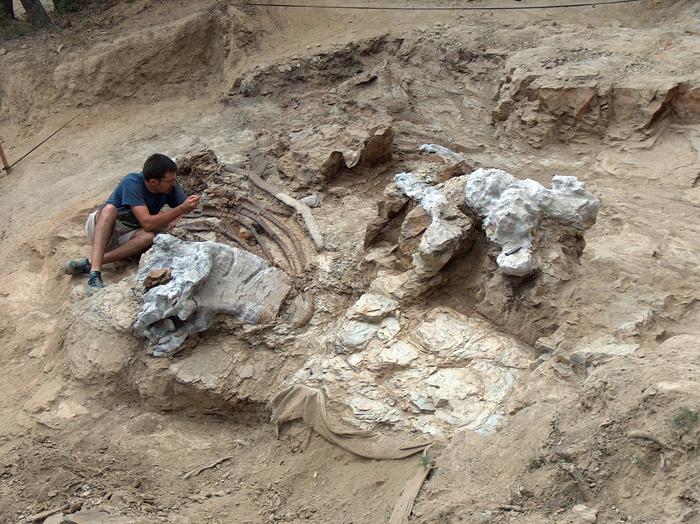In a remarkable revelation from the annals of prehistory, the newly discovered titanosaur, Garumbatitan morellensis, once roamed the land that is now modern-day Spain approximately 122 million years ago. The distinct morphology of its fossilized bones offers intriguing insights into the evolutionary history of these enigmatic long-necked giants, enhancing our understanding of this extraordinary lineage of dinosaurs.
Hailing from the Sant Antoni de la Vespa fossil site, nestled near the city of Morella, Garumbatitan morellensis has only recently stepped out of the shadows. Between 2005 and 2008, diligent researchers meticulously excavated the remains of at least three of these colossal creatures. The treasure trove included massive vertebrae, elongated leg bones, and two nearly complete sets of foot bones—an exceptionally rare discovery for sauropods. Radiocarbon dating places these fossils within the early Cretaceous period, spanning from 145 to 66 million years ago.

The unveiling of Garumbatitan morellensis has taken place through a scholarly exploration documented in the Zoological Journal of the Linnean Society, published on September 28.
Sauropods, the magnificent herbivorous giants such as Diplodocus and Brachiosaurus, with their extended necks and colossal tails, astound with their enormous proportions. Garumbatitan morellensis belongs to a distinctive subgroup within this lineage known as titanosaurs. These titans stood as the heaviest of sauropods and the sole lineage to endure until the cataclysmic asteroid strike, some 66 million years ago.
The precise measurements of Garumbatitan morellensis remain a subject of speculation due to the limited fossils unearthed. Nevertheless, one individual in particular stands out for its imposing size, characterized by vertebrae exceeding one meter in width and a femur capable of stretching up to two meters in length, as revealed by study lead author Pedro Mocho, a paleontologist affiliated with the University of Lisbon in Portugal. Although exact figures remain elusive, it is reasonable to infer that Garumbatitan morellensis would have fit comfortably within the realm of average-sized titanosaurs, who often reached dimensions rivaling a basketball court.
In the pantheon of titanosaur giants, the largest are undoubtedly Argentinosaurus huinculensis and Patagotitan mayorum, the debate surrounding which of these colossal creatures was the heaviest persists. Regardless, both are thought to have exceeded the staggering weight of 70 tons (63.5 metric tons). However, a groundbreaking discovery in 2021 unveiled the existence of an unnamed titanosaur species in Argentina, raising the tantalizing possibility of even more massive specimens than their famed counterparts.
It is worth noting that titanosaurs, while celebrated for their sheer mass, do not hold the record for length. That honor belongs to an unidentified sauropod, affectionately nicknamed “Supersaurus,” with an astonishing length of 128 feet (39 meters).
Crucially, the peculiar structure of Garumbatitan morellensis’ leg and foot bones presents it as one of the more primitive sauropods within the sub-group Somphospondyli. This lineage encompasses titanosaurs, as well as other elongated sauropods like Brachiosaurus. Researchers posit that somphospondylan fossils have been found on every modern continent, but the discovery of this primitive specimen in Spain suggests that Europe may have been the cradle of their existence. Yet, it remains an ongoing endeavor to amass the necessary evidence to substantiate this compelling hypothesis.
The Sant Antoni de la Vespa site, along with other locales within the Iberian Peninsula, are emerging as crucibles for our exploration of sauropod evolution. In a similar vein, 2022 bore witness to the revelation of the remains of an enormous unidentified sauropod in Portugal. This newfound specimen is a strong contender for the largest-known dinosaur fossil in Europe, offering a glimpse into a world that dates back 150 million years.
In the heart of Spain, Garumbatitan morellensis stands as a sentinel to a distant past, shedding light on the marvels of sauropod evolution. As the remnants of these ancient titans continue to be unearthed and examined, we inch closer to unlocking the secrets of the Earth’s prehistoric inhabitants.
